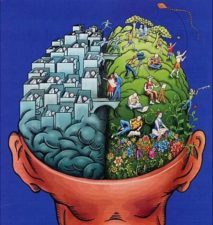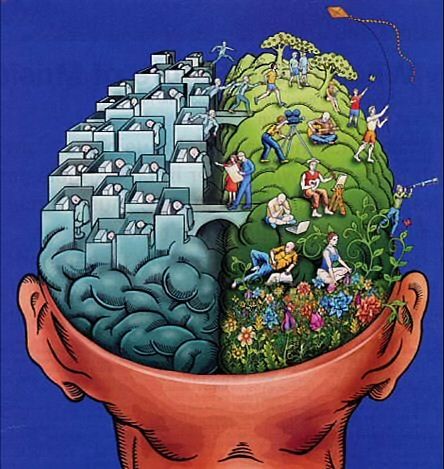
I was listening to a talk radio show a couple weeks ago on my way to work and the caller was talking about the differences in visual spatial skills in men and women. He didn’t go into any depth but it was interesting enough that I made note and wanted to learn more. I read up from theorists such as Louis Leon Thurstone, Jean Piaget, and Howard Gardner. After reading many articles and scientific studies about visual spatial awareness, spatial acuity, spatial memory, and the like, it’s not clear to me that it’s an issue of gender, but of what type of learner the person is.
There are two ways that our brains attempt to organize information: visual-spatial and auditory- sequential. Let’s take a moment and think about what it means to have visual spatial preference. This is a holistic view or approach. People who lean to this type of thinking tend to see the big picture. They are able to pick out the finer details from that picture too in order to understand the whole. It is a non-linear way to think in which time may not restrict the idea or solution. These are the people who can come up with creative solutions to problems.
People who favor auditory- sequential learning will be the ones who need to know a timeline and then follow steps, in order, to get to the solution. They will use deductive reasoning to analyze the information they are given or that they collect. It is a highly structured way of looking at solutions. Most of us use a combination of these in order to solve problems each day. But, in order to get the truly innovative and revolutionary ideas, you will need to find someone who can lean to the visual-spacial side more.
Let me give you a personal example. When I was in the 4th grade, my class was put through testing to find out who could be part of the STRETCH class. This class was made up of 4th- 6th graders who would spend time each day exploring creative solutions to world problems. One of the test questions was to take a circle and add lines to make something. Most of my peers added lines to make the circle look like a clock. I added curvy lines on each side to make mine look like a lemon. I’m not sure if that was a “right” answer, but it helped get me into the STRETCH class. I’d like to think it was because I was able to see something that many of the other kids didn’t. They went with what was a more logical answer. I went with something more creative.
In the workplace, we’re given problems to solve and projects to lead. Can you imagine that the type of thinking the leader has will have a direct impact on your solution? It certainly will. And, the team that the leader puts together will also have a strong impact on the method used to find that solution in addition to contributing to the creativity (or lack of) of the solution. Think that through the next time you have a task or project to assign. Here are some questions to ask:
- What type of leader will you need on the project? Do they need to be more creative, or find a more traditional solution?
- What are the time constraints? If that is critical, you may need to choose someone who has a stronger auditory- sequential focus.
- Are you trying to “best” your competition? Choose a visual-spatial leader here because he/ she will think big picture and foster more creativity.
What type of learner are you? Are you a blend, or do you tend to lean one way or the other? Share in the comments because I’d like to see if you think that has an impact on the type of leader you are.
Oh, and if you want to try some fun games to test your ability on being a visual-spatial learner, check out Happy Neuron.



4 Comments
I think that all problems need both sets of skills. Wouldn’t the best team be that which successfully leverages both types of thinking?
Having a diverse set of thinking brains on a team gives more possible answers and therefore has a greater chance of success. IMHO
The hard part is blending those two approaches within a team – conflicts are sure to arise when the linear and the non-linear go head to head.
I’m convinced that is the skill set we need for future success. Managing divergent thinking into a common direction and goal. But it is Monday and it’s early so I could be wrong … nah.
Successful hair dressers have to posess BOTH attributes, mainly as they must accomplish the follwing:
a) Seeing the whole picture in how to achieve a certain “look” one wants or envisioning a new ‘do
b) Listening to all of the concerns and challenges that the client has when pursuing the new look
c) Knowing how to use cosmetic chemical preparations properly to achieve the said look.
d) Knowing the “rules” of how hair reacts to different cutting techniques.
d) Seeing the “big picture” in one’s business and how to change the big picture.
So many times in a creative business, the auditory-sequential gets lost, as we’re always trying to be creative for the sake of creativity, rather than doing what keeps our doors open: focus on clients. I was too spatial for so long. I am trying to hone the auditory-sequential parts.
Great stuff, as always.
I’ve been focusing on understanding my clients’ learning styles, so that I can understand them better and communicate with them better — on their terms. Interestingly, people leave verbal clues to their dominate styles. Visual learners will say, “I see what you mean,” or “I just can’t picture that.” Auditory learners respond with “I hear you!” or “That just doesn’t sound right.” A third kind of learner, kinesthetic learners, tend to learn by doing. They drop hints such as “Oh, I can do that” and “That just doesn’t feel right.” I’m starting to see that while I have a dominate learning style, I need to see my clients’ learning styles so they can hear me. After all, I want them to feel good about our work together.
While learning styles correlate to intelligence types, I don’t think it’s a one-one relationship. We all have a blend of intelligence types, allowing us to seem smart and stupid in the same day. It seems to me that the key is understanding ourselves and those around us to get the most from the team.
This site, originated by a woman with learning disabilities, helps to explain the theory:
http://www.ldpride.net/learningstyles.MI.htm
Trish, thanks for opening up this conversation. I look forward more feedback.
Great post Trish. I’ve been diving into this realm myself. By nature, I am more left brained, but I’m learning the importance of developing the right side. Take for instance drawing. My skills haven’t improved since I was a little kid, sadly they probably declined. That is a right brain skill set that got ignored. I think the ability to problem solve is a right brain function. Dan Pink said it nicely, “Left is necessary, but right is sufficient!”
I’m doing my best to exercise the right side of my brain. I want to be a “whole brain” leader.
http://growingforward.net